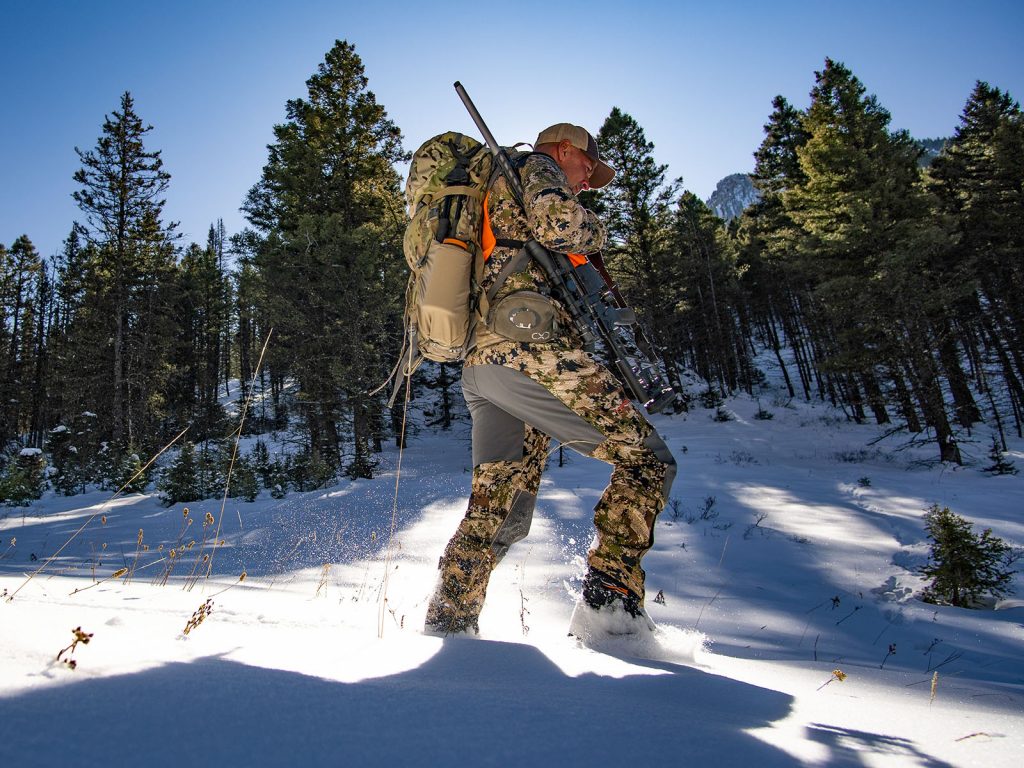
MODULE 15 - POST-RUT & LATE-SEASON
CHAPTER 3: TACTICS FOR POST-RUT & LATE-SEASON ELK HUNTING

RANDY NEWBERG:
APPLYING THE STRATEGY
There are a lot of similarities in how I hunt the Post-Rut and Late-Season for elk, both in terms of tactics and in terms of day-by-day strategy. I would say the biggest difference between these two seasons is the fact that the bulls are primarily in solitary mode in the Post-Rut. By the time the Late-Season comes around, they’re starting to form the bachelor groups that they’re going to spend the winter in. And that’s why I always say that the Post-Rut is the hardest period to find a bull elk. He’s solitary. He’s solo. He’s not hanging around with a bunch of buddies, and he’s in some nasty places. He’s not making noise, so you can’t use a call to your advantage. That’s the toughest time. And coincidentally, that’s when most rifle elk hunts occur in the West. Besides the fact that they’re in bachelor groups and it’s easier to locate them, the Late-Season often brings another major benefit: weather.
It’s very unlikely that you’ll experience full-on wintertime conditions during the Post-Rut period, which is why I break these two seasons out separately. But the tactics for both seasons are pretty much the same. And the primary tactic that is going to deliver success in the Post-Rut and Late-Season is using quality optics. You’re going to be sitting there, spending countless hours just looking through your binoculars and spotting scope, trying to find the elk as they slip in and out of their sanctuaries.
If you are lucky enough to have snow on the ground during a Post-Rut or Late-Season hunt, your job just got a whole lot easier. Now you have a physical sign of where the elk are, and I’m talking about reading tracks. You won’t necessarily start following the tracks and “track down” the elk, but I’m talking about reading tracks from a half-mile or a mile away. And you might be thinking, How can you know what’s going on if you see tracks in the snow from a mile away? Here’s a couple of things to understand when it comes to seeing elk tracks from a distance.
Let’s say you see a group of elk tracks going across a hillside, and there are 20-30 sets of tracks. I can just about guarantee you that this is a group of cows, calves, and young bulls. That’s not what you’re looking for. We’re looking for a mature bull elk. So, if I see a set of tracks higher on the ridge and there are 2 or 3 tracks, that is more likely going to be a group of bulls, especially after November 1st. I know that the bulls like to hang out higher, so if I’m not seeing any groups of cow/calf tracks, and all of a sudden find a couple tracks up high, it’s likely bulls.
One more important aspect of reading these tracks is determining what they are doing. If you see those 2 or 3 tracks that are just straight-lining across the hillside, those bulls are likely moving somewhere else. They’re likely heading to a different sanctuary somewhere closer to the winter range. Odds are, they’re not still there. It doesn’t mean some more won’t come through, but those tracks you’re seeing are not the elk you’re probably going to be hunting that day.
However, if you see those 2 or 3 tracks and they’re meandering and weaving and bobbing in and out of the trees, or slipping out into a burn or an avalanche chute area, those are likely the tracks of feeding bulls. Those bulls are likely hanging out closeby, living in their sanctuary area, and those tracks tell you that they are probably still there. Those are the tracks and the bulls I’m going to hunt right then. It’s a blessing if you have snow – it gives you the confidence that you’ve got something there to hunt. In this situation, I’m going to sit there all day long until those bulls come out. And there is a really good chance that they will!
Reading tracks in the snow is not absolutely precise, but it’s very close to precise and it will allow you to eliminate a whole bunch of guessing and a whole bunch of locations that you might otherwise have wasted time hunting.
MY DAY-TO-DAY STRATEGY
I mentioned that glassing is my primary tactic in the Post-Rut and Late-Season. And I've also talked about my glassing locations often being a mile or more from the actual sanctuaries that I am going to be looking into. The odds are, if I see a bull that morning, he's going to get to his bed before I can get over there, play the wind, and get in position. So, that means I’m going to need a strategy for hunting him at some point in the future (that afternoon, next morning, etc.).
If I am glassing from one of my glassing spots in the morning and I see a bull or a group of bulls next to a sanctuary, I will usually watch them head back into their bedding area. I know where they went, and I know they aren’t going to be leaving that area. They are there and they're going to come out somewhere nearby that same location that afternoon. I don’t necessarily know exactly where, but I do know they will come out somewhere close by that afternoon.
So, I'm going to use the remainder of the day to figure out the best way to get over there to get set up. I want to set up in a shooting position either above them or across from them (not below them as I won’t be able to see as well). However I decide to set up, the location has to be a place that will keep the wind in my favor.
Corey has talked about thermals and the obeying the wind multiple times as he talks about Early-Season, Pre-Rut, and Peak-Rut hunting. But it’s critical to remember that even in the Post-Rut and Late-Season, elk are using their sense of smell to survive, and you cannot fool an elk’s nose. When you are determining where to set up, you have to be paying attention to the wind!
With that in mind, you're going to want to get over there and be set up when that bull comes out that afternoon or evening. You are going to be ready, and you're going to kill him! This means that you had better have headlamps and a good backpack. You had better be capable and ready to take care of a big bull elk in the dark, and then pack a heavy load back out in the dark.
One thing to keep in mind as you are hiking in there for the afternoon hunt is to mark the locations on your GPS. Whether you have a traditional GPS or an app on your smartphone, the benefit of going in there during the daylight hours is that you now have a good trail marked which makes it easier to get back out in the dark. You can find the easiest way in - and back out - with the least amount of debris and headache in the daylight.

Now, whether you hike back out with a loaded pack in the dark, or not, you can hike out by following the trail you established in the daylight. You can also easily be back in there the next morning if for some reason you don’t shoot him that afternoon.
If that's my situation, and I don't kill him that evening, I'm back in there before daylight the next morning. I stay set up there, ready for a shot, all day long. I know they are there, so I'll do that for at least another day - sometimes two days - knowing that sooner or later, they're going to come out. I just want to make sure you understand that if you find elk in a sanctuary in a Post-Rut or Late-Season hunt, do not leave them! You know they are there, and Post-Rut and Late-Season elk do not move very much at all unless they are disturbed by hunting pressure.
If you've found them, stay on them. Keep hunting your system, and you're going to kill one!
USING HUNTING PRESSURE TO YOUR ADVANTAGE
One thing you can almost always count on for Post-Rut and Late-Season elk hunts is that you’re going to have company. The majority of the rifle elk tags are issued these seasons, so on Public Land, you can expect to encounter some hunting pressure. So, what does it do to the elk, and how do you deal with it?
Hunting pressure is the primary reason I always focus on sanctuaries during the Post-Rut and Late-Season. Hunting pressure means human activity, and human activity moves elk away from human activity. The elk want to go places where they're not disturbed, a place where they can just make a living in a small, 10-acre patch and get through hunting season.
What does hunting pressure look like? Well, it looks different throughout the day. It looks different throughout the week. And it looks different throughout the season. We all know that hunting pressure is heaviest in the morning. Everybody's excited, so they jump in their truck and drive out to the trailhead and start hiking in. Because of that, you need to be the first person on the trail and be up at your glassing location way before the sun comes up.
There's often going to be a lot of people, especially early in the season, and the majority of them are not going to be at a glassing spots when the sun comes up. They are the ones who will be bumping elk and pushing elk, and in my sanctuary locations and my glassing spots, I'm going to see those elk responding to hunting pressure. They’re going to be on the move, and I can take advantage of that.
If I’m in a good glassing location, I’ll be able to see where the elk are moving to as they get pressured. I'm going to be able to see where they go and where they bed down to escape the pressure. Finding elk that aren’t pressured isn’t too difficult. Finding them amidst heavy hunting pressure can seem nearly impossible. So, being there to see what the elk do when they get pressured can be very helpful, and it can help us solve that “90% problem” – finding the elk.
And just as there are daily peaks and valleys in the hunting pressure, we see the same thing during the week. As you probably guessed, the biggest peak in hunting pressure during the week hits Saturday and Sunday. Instantly, on Saturday morning, the elk respond to that pressure and they head to the deepest, darkest, ugliest place they can find - the sanctuaries that are the hardest to hunt.
The hunting pressure subsides Sunday afternoon, maybe Monday. The elk can sense that. There's less noise in the woods. There's less scent, less movement, and less activity. By about Wednesday, Thursday, Friday, the elk are starting to feel like maybe season's over. They respond differently. But on Saturday, I'm going to be back there in the deepest, farthest places from roads, or down in the deepest canyons, glassing where the elk will be heading when they start to feel the pressure from other hunters.
And I'm going to be back there in that same area again on Sunday. The pressure is still there and the elk know it. If I know there is going to be pressure, I'm just kind of putting myself out in front of the hunting pressure. By Monday Tuesday or Wednesday, I might start moving around a little bit, and not worrying quite as much about all the hunting pressure pushing everything around.
There are definitely things about hunting pressure that you can use to your advantage. You just need to understand - and it's really just common sense - how elk respond to the hunting pressure. Let those hunters become a tool for you. And when we’re talking about sanctuaries, very often the boundaries we talked about earlier can create sanctuaries of low hunting pressure.
For instance, if you know there is a boundary of public/private land, and an outfitter hunts the private land but isn’t in there on certain days, use that to your advantage. Say he hunts Monday through Friday. The elk might stack up in there on Saturday and Sunday as they get pressure on the public land. But on Monday morning, when the outfitter gets a new rotation of clients, they're going to start pushing some of those elk back over to the public land where there is decreased pressure during the week. Used those kinds of things to your advantage.
Think about what hunting pressure really is. Hunting pressure is human presence in the hills. It's that simple. Go to the areas where the pressure is the least. And remember when are the peak periods of pressure are, and when are the low periods are. Elk will respond to those periods of pressure. The further you get from those peak periods, the more likely you will be able to find elk.
THE MENTAL GAME
In this Module, I've been talking about Post-Rut and Late-Season hunting. I've talked about how it's a glassing game - you can leave the elk calls at home. And because you don't need elk calls, sometimes Post-Rut and Late-Season elk hunting can be considered boring. You're just sitting there and glassing. But glassing becomes a game all of its own. It's a mental game. It's a game of you versus your body. It's a game of you versus the conditions. It’s a game of you versus the elk. Who's going to blink first?
So let's talk about your body. You had better have good clothing, because the odds are that it's going to be a colder during these hunts. You're probably going to be hiking in to a glassing spot, which means you will likely get sweated up. Do not leave the truck all bundled up. What I usually wear when I'm hiking in during November is a merino wool base layer with a good vest (or any highly breathable clothing). In my pack I have a puffy coat, and I have some sort of wind stopper outer layer. I have mittens (not gloves) and I have a stocking cap. I also have an extra pair of socks. The surest way to get your mind wanting to go back to the truck is if your body starts telling it that it’s not comfortable. You have to stay warm.
Have good clothing that will not allow you to overheat and get too sweaty while you are hiking in, and have good clothes that you can put on to endure long sits in cold weather. If you stay warm from the wind or the cold temperatures - or a combination of both - your mind is going to be focused.
Now that your body is comfortable and able to withstand the elements, you are prepared to just sit there all day. Mentally, that can be tough! How do you get through it? If you have a hunting partner, that definitely helps. I know I can sit there for a lot longer if I have someone I'm sharing the glassing with. I know some people just like to hunt by themselves, and that's fine. There are other ways to make it through a long, cold day of just sitting there.
If it's cold, start a fire. Do not hesitate to start a little fire. Elk aren’t afraid of fires. The places they live in burn every year. A fire will keep your mind off the fact that you're cold. And once you get a fire started, it warms you up and keeps you warm. It gives you a nice little distraction as you keep it going all day.
Understand the prime times for glassing. In the morning, that first half-hour or hour is going to be prime-time. In the evenings, that last hour of daylight is going to be the best. If you need to take a nap, do it in the middle of the day. But even then, don't give up on glassing your Sanctuary areas. Be glassing throughout the day, because in the middle of the day, a bull might get up to take a pee, grab a little bite to eat, or just change locations to take better advantage of the wind. It's amazing how many times I'll look at an area I swear I’ve looked at 100 times, and all of a sudden, now I see antlers there. That's why it's so important to stay mentally focused and be willing to do that all day long.
I know it's a mental game. I know you aren't hearing bulls bugling. You're not running towards bugles. You're not calling elk in. I mean, it's not that level of excitement. It's not that engaging. It requires a special person to sit there behind their optics all day long for the whole season, but it works. There's a reason why the majority of hunters who are most successful in Post-Rut and Late-Season public land elk hunts are the ones who are the best with their glass. A large part of the reason why they're good with their optics is because mentally they can stay sharp and focused.
Don't let the mental part of Post-Rut and Late-Season elk hunting distract you from doing what you have to do. Once you find the elk, 90% of your work is done. Now you just have to do the other 10% and figure out how to kill them. And that’s the easy part!
Click ‘Next Module’ Below to Continue to "Hunting Roosevelt Elk"...




